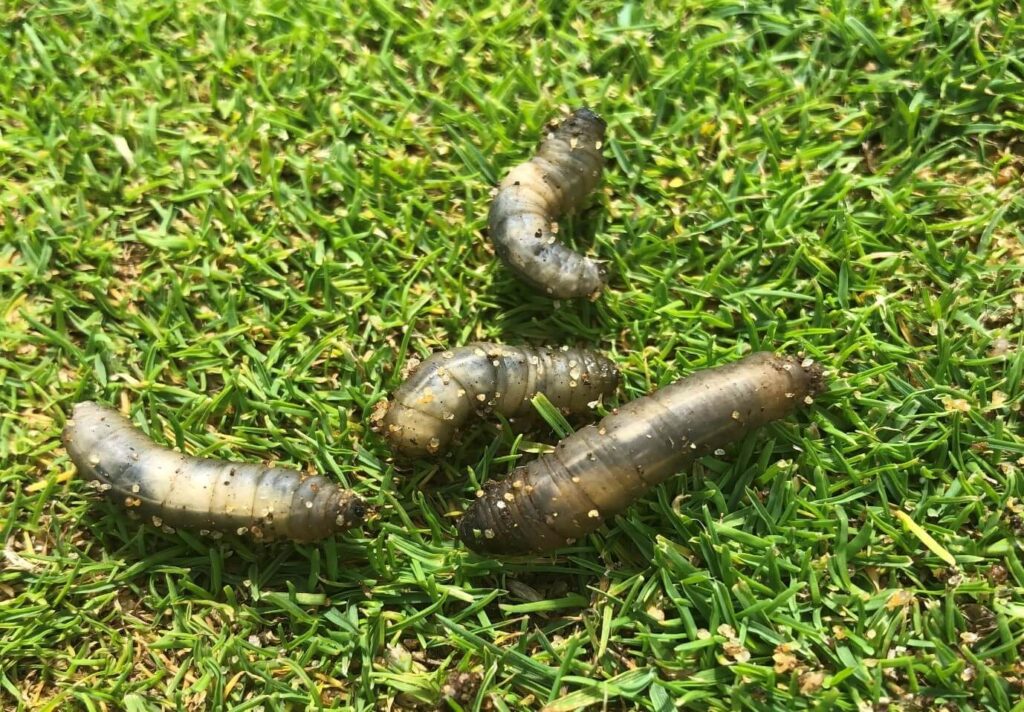
Having problems with leatherjackets?
Leatherjackets are the larval stage of the crane fly or daddy-long-legs, they are about 2.5cm (1″ long), greyish black in colour, legless and with no distinct head.
Additional Information
These pests are the larvae of craneflies, which encompass around 350 species in Britain, spanning six true fly families: Tipulidae, Pediciidae, Limoniidae, Cylindrotomidae, Trichoceridae, and Ptychopteridae. While many of these species are rare and contribute to healthy ecosystems by feeding on decomposing organic matter or algae, a few feed on living plant material and can cause garden damage. Leatherjackets have elongated, tubular bodies up to 30mm long, are greyish-brown and lack legs or an obvious head. They cause lawns to develop yellowish-brown patches, often killing the grass, distinguishable by lifting the affected turf to find leatherjackets in the soil. Water soaking and covering the lawn with light-impervious material can reveal large numbers of grubs if leatherjackets are the issue. Birds like crows, magpies, rooks, and starlings searching for leatherjackets leave small round holes in the turf. In flower beds or vegetable plots, leatherjackets can kill seedlings and small plants by damaging stems at the soil level.
Remedy:
When you start to see daddy-longlegs in your garden, which is normally towards the end of August, you will know that in a few days they will be laying eggs in your lawn. This is when the young leatherjackets are active in the soil and are most susceptible to the treatment we provide.
Make sure the lawn does not dry out after we apply the treatment and keep it well watered for at least two weeks. This is very important to ensure the biological control works effectively and the leatherjackets are eradicated from your lawn.
DO LEATHERJACKETS CARRY DISEASES?
Leatherjackets, the larvae of crane flies (commonly known as daddy longlegs), are not known to transmit any diseases to humans or animals.
Are Leatherjackets Harmful?
While they do not pose a direct health risk, leatherjackets can be a significant pest in gardens and lawns. They feed on grass roots, causing patches of dead or dying grass, and can also damage crops.
Do Leatherjackets Bite or Sting?
Leatherjackets do not bite or sting. They are purely a nuisance in terms of the damage they cause to plants and turf.
Managing Leatherjacket Infestations
Preventative measures such as encouraging natural predators (e.g., birds and nematodes) or using biological treatments can help control leatherjacket populations without the need for chemical pesticides.
Request a Quote Today
Reach Us
Location :
4 Compton Close, Didcot, Oxfordshire, OX11 7HD
Email :
office@shire-pest-solutions.co.uk
Phone :
01235399073
Leatherjackets FAQ
1. What are leatherjackets?
Leatherjackets are the larvae of crane flies (commonly known as daddy longlegs). They are grey-brown, legless grubs that live underground and feed on grassroots, causing damage to lawns and turf.
2. How do I know if I have a leatherjacket infestation?
Signs include yellow or patchy grass, loose turf that lifts easily, and increased activity of birds, such as starlings or crows, pecking at your lawn to feed on the larvae.
3. When are leatherjackets most active?
Leatherjackets are typically active from late summer through spring. Eggs are laid in late summer, and larvae feed underground throughout autumn, winter, and early spring before pupating into crane flies.
4. Can leatherjackets damage my garden or lawn?
Yes, leatherjackets feed on grassroots, which weakens turf and can result in brown patches, poor lawn health, and even complete grass loss if the infestation is severe and untreated.
5. Do you treat leatherjackets in my area?
Yes, Shire Pest Solutions offers professional leatherjacket control services across Didcot, Wallingford, Abingdon, Wantage, Witney, Newbury, Thame, Thatcham, and Stokenchurch. We use targeted treatments to protect and restore your lawn.
More About Shire Pest Solutions
Shire Pest Solutions is a trusted and local pest control company proudly serving homes and businesses across Oxfordshire and beyond. With a reputation built on professionalism, reliability, and fast response times, we specialise in the safe and effective removal of pests including ants, wasps, rodents, bed bugs, and more.
Our expert technicians are fully qualified and equipped with the latest tools and treatments to ensure pest problems are resolved quickly and safely—without unnecessary disruption. Whether it’s a minor domestic issue or a large-scale commercial infestation, we tailor our services to meet your needs with minimal fuss and maximum effectiveness.
Based locally, we regularly assist customers in Didcot, Wallingford, Abingdon, Wantage, Witney, Newbury, Thame, Thatcham, and Stokenchurch. Our knowledge of the local area enables us to provide rapid call-outs and treatments that are suited to the unique pest challenges of each location.
At Shire Pest Solutions, we don’t just eliminate pests—we help prevent them from returning. With transparent pricing, no hidden fees, and a dedication to customer satisfaction, we are the go-to pest control provider for homeowners, landlords, and commercial clients alike.
Get in touch today to arrange a call-out or learn more about our pest control services across Oxfordshire and surrounding areas.
Professional Pest Control Services Across Oxfordshire & Berkshire
In Your
Area Today
Pest Control Oxfordshire – Our Coverage Areas
Call us today or use our online contact form to arrange a visit with one of our experienced, expert pest control technicians.
